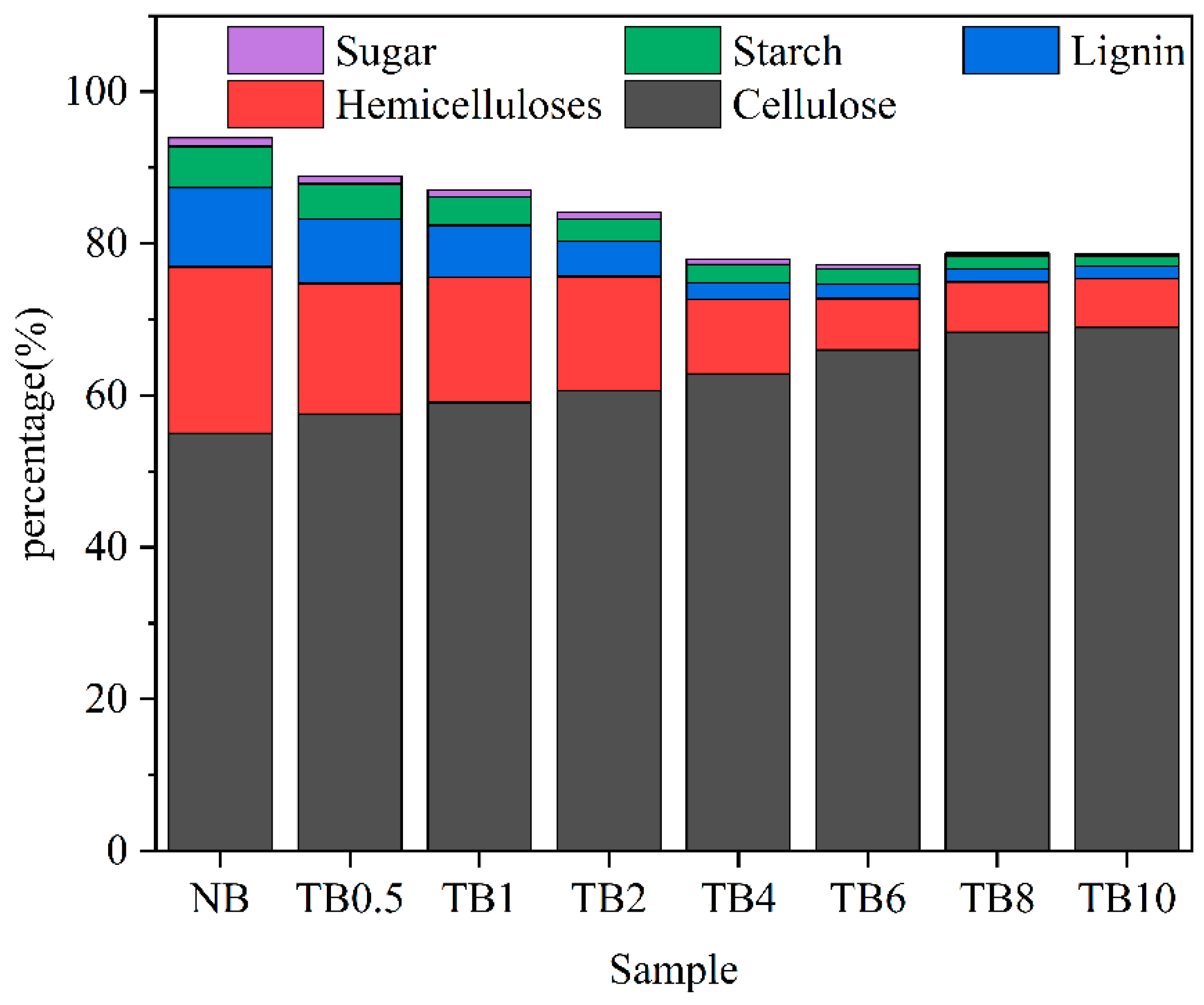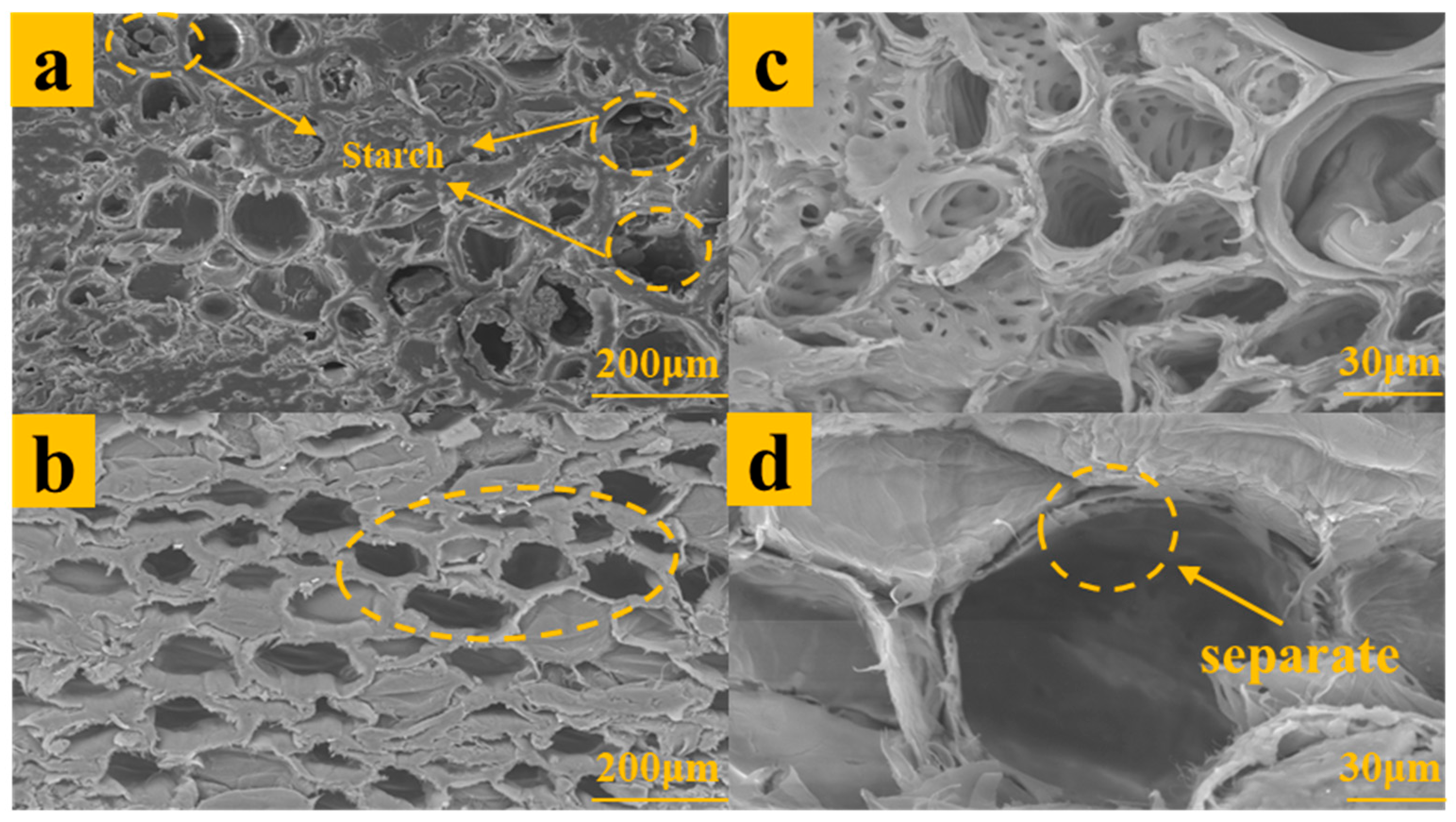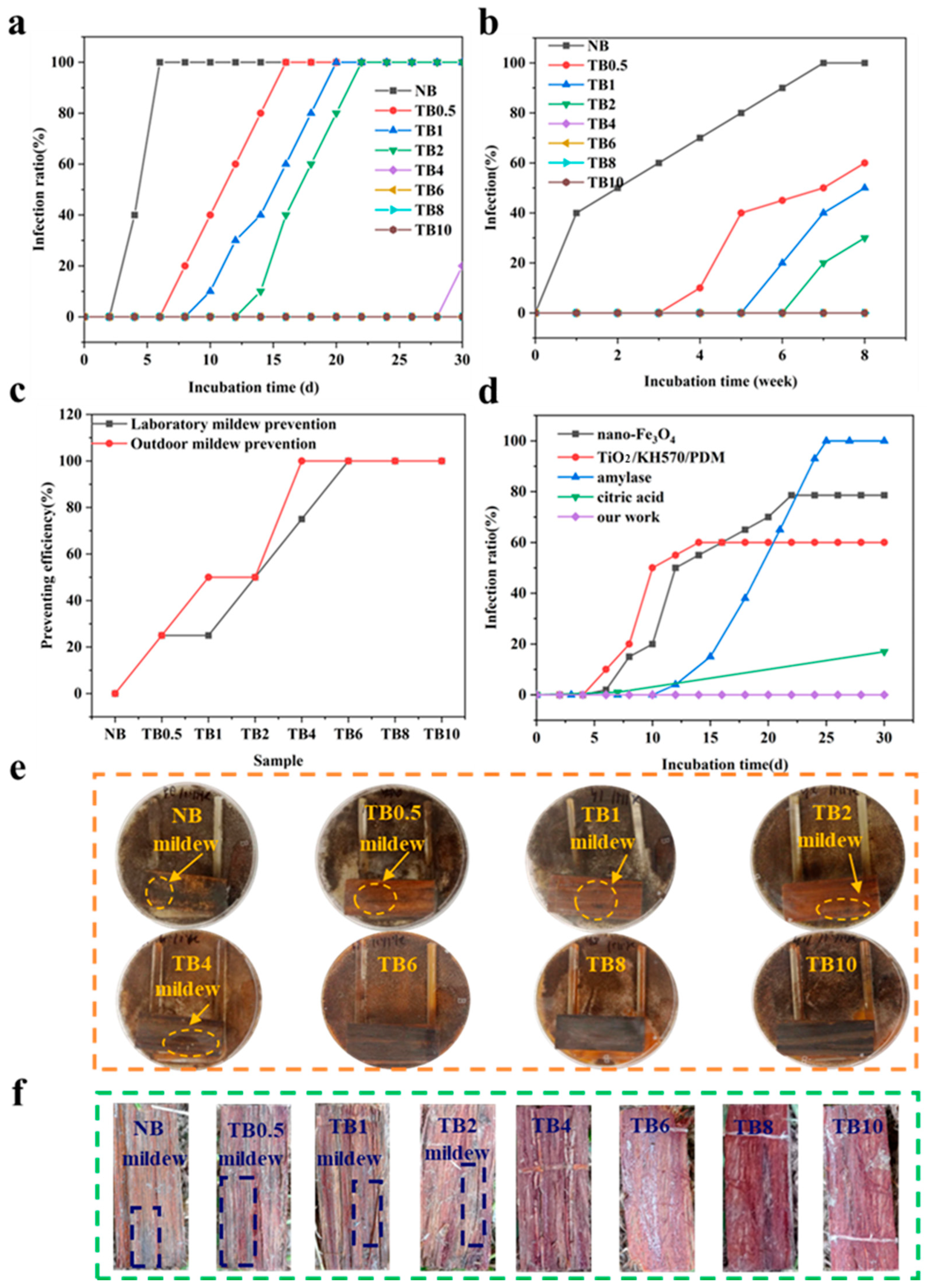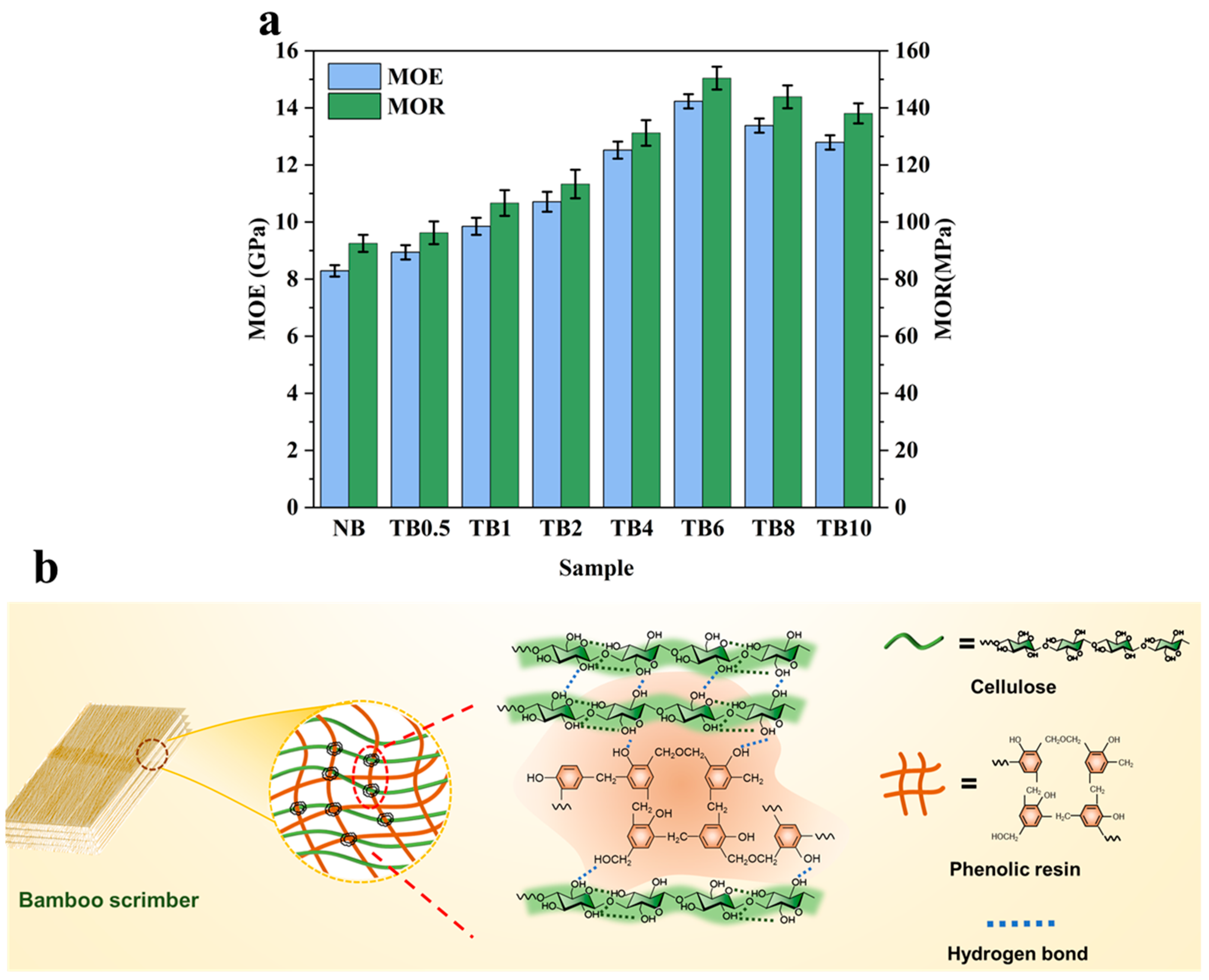A Simple and Effective Method to Enhance the Mechanical Properties, Dimensional Stability, and Mildew Resistance of Bamboo Scrimber
Abstract
1. Introduction
2. Experimental Section
2.1. Materials
2.2. Treatment of Bamboo Bundles
2.3. Preparation of Bamboo Scrimer
2.4. Anti-Mildew Property
2.5. Mechanical Properties
2.6. Dimensional Stability
2.7. pH Measurement
2.8. Chemical Analysis
3. Results and Discussion
3.1. Chemical Characterization
3.2. Composition and Morphology Characterization
3.3. Anti-Mildew Property
3.4. Mechanical Properties
3.5. Dimensional Stability
4. Conclusions
Supplementary Materials
Author Contributions
Funding
Data Availability Statement
Acknowledgments
Conflicts of Interest
References
- Wang, Q.; Han, H.; Lou, Z.; Han, X.; Wang, X.; Li, Y. Surface property enhancement of bamboo by inorganic materials coating with extended functional applications. Compos. Part A Appl. Sci. Manuf. 2022, 155, 106848. [Google Scholar] [CrossRef]
- Chen, J.; Guagliano, M.; Shi, M.; Jiang, X.; Zhou, H. A comprehensive overview of bamboo scrimber and its new development in China. Eur. J. Wood Wood Prod. 2021, 79, 363. [Google Scholar] [CrossRef]
- Fang, C.-H.; Jiang, Z.-H.; Sun, Z.-J.; Liu, H.-R.; Zhang, X.-B.; Zhang, R.; Fei, B.-H. An overview on bamboo culm flattening. Constr. Build. Mater. 2018, 171, 65. [Google Scholar] [CrossRef]
- Huang, Z.; Sun, Y. Experimental study on the surface light and thermal properties of bamboo. J. Build. Eng. 2021, 37, 102126. [Google Scholar] [CrossRef]
- Nkeuwa, W.N.; Zhang, J.L.; Semple, K.E.; Chen, M.L.; Xia, Y.L.; Dai, C. Bamboo-based composites: A review on fundamentals and processes of bamboo bonding. Compos. Part B Eng. 2022, 235, 109776. [Google Scholar] [CrossRef]
- Yu, Y.; Zhu, R.; Wu, B.; Hu, Y.; Yu, W. Fabrication, material properties, and application of bamboo scrimber. Wood Sci. Technol. 2015, 49, 83. [Google Scholar] [CrossRef]
- Huang, Z.; Künzel, H.; Krus, M.; Zhang, W. Three-dimensional tests on hygric properties of laminated bamboo and bamboo scrimber. J. Build. Eng. 2022, 56, 104712. [Google Scholar] [CrossRef]
- Zhang, J.; Zhang, B.; Chen, X.; Mi, B.; Wei, P.; Fei, B.; Mu, X. Antimicrobial bamboo materials functionalized with ZnO and graphene oxide nanocomposites. Materials 2017, 10, 239. [Google Scholar] [CrossRef] [PubMed]
- Li, H.; Yang, Z.B.; Yang, F.; Gu, Z.C.; Liu, R.; Yu, L.L.; Ma, X.X.; Fei, B.H. Influence of Four Coatings on the Mold-Resistance and Combustion Performance of Decorative Bamboo Curtain. Wood Fiber Sci. 2018, 50, 447. [Google Scholar] [CrossRef]
- Lin, J.T.; Liu, H.; Wang, S.Q.; Huang, J.D.; Zhang, W.B. Preparation and Influence Mechanism of High-Efficiency Bamboo-Based Conductive Carbon Powder by One-Step Carbonization. J. Biobased Mater. Bioenergy 2023, 17, 14. [Google Scholar] [CrossRef]
- Guan, M.J.; Huang, Z.W.; Zhu, D.Y. The effect of ultrasonic process on the shear strength and the microstructure of the bonding interface of laminated bamboo lumber. Eur. J. Wood Wood Prod. 2022, 80, 1401. [Google Scholar] [CrossRef]
- Huang, Y.X.; Meng, F.D.; Liu, R.; Yu, Y.L.; Yu, W.J. Morphology and supramolecular structure characterization of cellulose isolated from heat-treated moso bamboo. Cellulose 2019, 26, 7067. [Google Scholar] [CrossRef]
- Lin, Q.Q.; Huang, Y.X.; Yu, W.J. An in-depth study of molecular and supramolecular structures of bamboo cellulose upon heat treatment. Carbohydr. Polym. 2020, 241, 116412. [Google Scholar] [CrossRef]
- Poonia, P.K.; Deepa, S.R.; Kumar, M.; Kumar, A. Viability of wood decaying fungal mycelium after microwave radiation of bamboo culm. Maderas-Cienc. Tecnol. 2021, 23, 1–6. [Google Scholar] [CrossRef]
- Chee, S.S.; Jawaid, M.; Sultan, M.; Alothman, O.Y.; Abdullah, L.C. Thermomechanical and dynamic mechanical properties of bamboo/woven kenaf mat reinforced epoxy hybrid composites. Compos. Part B Eng. 2019, 163, 165. [Google Scholar] [CrossRef]
- Liang, H.S.; Xing, H.; Qin, M.; Wu, H.J. Bamboo-like short carbon fibers@Fe3O4@phenolic resin and honeycomb-like short carbon fibers@Fe3O4@FeO composites as high-performance electromagnetic wave absorbing materials. Compos. Part A Appl. Sci. Manuf. 2020, 135, 105959. [Google Scholar] [CrossRef]
- Jhu, Y.S.; Hung, K.C.; Xu, J.W.; Wu, J.H. Effects of acetylation on the thermal decomposition kinetics of makino bamboo fibers. Wood Sci. Technol. 2019, 53, 873. [Google Scholar] [CrossRef]
- Papadopoulos, A.N.; Bikiaris, D.N.; Mitropoulos, A.C.; Kyzas, G.Z. Nanomaterials and Chemical Modifications for Enhanced Key Wood Properties: A Review. Nanomaterials 2019, 9, 607. [Google Scholar] [CrossRef]
- Li, J.P.; Wu, Z.X.; Bao, Y.J.; Chen, Y.H.; Huang, C.J.; Li, N.; He, S.; Chen, Z. Wet chemical synthesis of ZnO nanocoating on the surface of bamboo timber with improved mould-resistance. J. Saudi Chem. Soc. 2017, 21, 920. [Google Scholar] [CrossRef]
- GB/T 18261-2013; Test Method for Anti-Mildew Agents in Controlling Wood Mould and Stain Fungi. China National Standardization Management Committee: Beijing, China, 2013.
- GB/T 17657-2013; Test Methods of Evaluating the Poperties of Wood-Based Panels and Surface Decorated Wood-Based Panels. Standardization Administration of the People’s Republic of China: Beijing, China, 2013.
- GB/T 6043-2009; Method for Determination of pH Value of Wood. Standardization Administration of the People’s Republic of China: Beijing, China, 2009.
- Segal, L.; Creely, J.J.; Martin, A.E.; Conrad, C.M. An Empirical Method for Estimating the Degree of Crystallinity of Native Cellulose Using the X-Ray Diffractometer. Text. Res. J. 1959, 29, 786. [Google Scholar] [CrossRef]
- Bartos, A.; Anggono, J.; Farkas, A.E.; Kun, D.; Soetaredjo, F.E.; Móczó, J.; Antoni; Purwaningsih, H.; Pukánszky, B. Alkali treatment of lignocellulosic fibers extracted from sugarcane bagasse: Composition, structure, properties. Polym. Test. 2020, 88, 106549. [Google Scholar] [CrossRef]
- Liu, K.; Du, H.S.; Zheng, T.; Liu, H.Y.; Zhang, M.; Zhang, R.; Li, H.; Xie, H.; Zhang, X.; Ma, M.; et al. Recent advances in cellulose and its derivatives for oilfield applications. Carbohydr. Polym. 2021, 259, 117740. [Google Scholar] [CrossRef]
- Oprea, M.; Voicu, S.I. Recent advances in composites based on cellulose derivatives for biomedical applications. Carbohydr. Polym. 2020, 247, 116683. [Google Scholar] [CrossRef]
- Lin, J.Y.; Yang, Z.X.; Hu, X.X.; Hong, G.H.; Zhang, S.B.; Song, W. The Effect of Alkali Treatment on Properties of Dopamine Modification of Bamboo Fiber/Polylactic Acid Composites. Polymers 2018, 10, 403. [Google Scholar] [CrossRef]
- Lu, M.T.; He, W.; Li, Z.; Qiang, H.; Cao, J.Z.; Guo, F.; Wang, R.; Guo, Z. Effect of Lignin Content on Properties of Flexible Transparent Poplar Veneer Fabricated by Impregnation with Epoxy Resin. Polymers 2020, 12, 2602. [Google Scholar] [CrossRef]
- Yang, L.; Lou, Z.; Han, X.; Liu, J.; Wang, Z.; Zhang, Y.; Wu, X.; Yuan, C.; Li, Y. Fabrication of a novel magnetic reconstituted bamboo with mildew resistance properties. Mater. Today Commun. 2020, 23, 101086. [Google Scholar] [CrossRef]
- Ma, C.Y.; Wang, H.M.; Wen, J.L.; Shi, Q.T.; Wang, S.F.; Yuan, T.-Q.; Sun, R.-C. Structural elucidation of lignin macromolecule from abaca during alkaline hydrogen peroxide delignification. Int. J. Biol. Macromol. 2020, 144, 596. [Google Scholar] [CrossRef] [PubMed]
- Rao, F.; Ji, Y.H.; Yang, Y.; Zhang, Y.H.; Li, N.; Yu, W.; Chen, Y. Rapid Process Natural Bamboo into Outdoor Bamboo-Fiber-Reinforced Composite with High Surface Photostability. Forests 2021, 12, 446. [Google Scholar] [CrossRef]
- Feng, N.R.; Liang, Y.X.; Hu, D.Y. Delignified bamboo as skeleton matrix for shape-stable phase change heat storage material with excellent reversible thermochromic response property. J. Energy Storage 2020, 30, 101401. [Google Scholar] [CrossRef]
- Dong, Y.M.; Liu, X.Y.; Liu, J.J.; Yan, Y.T.; Liu, X.R.; Wang, K.; Li, J. Evaluation of anti-mold, termite resistance and physical-mechanical properties of bamboo cross-linking modified by polycarboxylic acids. Constr. Build. Mater. 2021, 272, 121953. [Google Scholar] [CrossRef]
- Chen, H.; Wu, J.; Shi, J.; Zhang, W.; Wang, H. Effect of alkali treatment on microstructure and thermal stability of parenchyma cell compared with bamboo fiber. Ind. Crops Prod. 2021, 164, 113380. [Google Scholar] [CrossRef]
- Felisberto, M.H.F.; Beraldo, A.L.; Costa, M.S.; Boas, F.V.; Franco, C.M.L.; Clerici, M.T.P.S. Characterization of young bamboo culm starch from Dendrocalamus asper. Food Res. Int. 2019, 2, 222–229. [Google Scholar] [CrossRef]
- Huang, X.D.; Hse, C.Y.; Shupe, T.F. Study on the Mould-Resistant Properties of Moso Bamboo Treated with High Pressure and Amylase. Bioresources 2014, 497, 497–509. [Google Scholar] [CrossRef]
- Lou, Z.; Han, X.; Liu, J.; Ma, Q.; Yan, H.; Yuan, C.; Yang, L.; Han, H.; Weng, F.; Li, Y. Nano-Fe3O4/bamboo bundles/phenolic resin oriented recombination ternary composite with enhanced multiple functions. Compos. Part B Eng. 2021, 226, 109335. [Google Scholar] [CrossRef]
- Yu, Z.X.; Zhang, X.F.; Zhang, R.; Yu, Y.; Sun, F.B. Improving the Mould and Blue-Stain-Resistance of Bamboo through Acidic Hydrolysis. Polymers 2022, 14, 244. [Google Scholar] [CrossRef]
- Liu, Y.D. Bamboo timber mildew and anti-mold technology. Trans. Tech. Publ. 2012, 4, 139–144. [Google Scholar] [CrossRef]
- Bacigalupe, A.; Molinari, F.; Eisenberg, P.; Escobar, M.M. Adhesive properties of urea-formaldehyde resins blended with soy protein concentrate. Adv. Compos. Hybrid Mater. 2020, 3, 213–221. [Google Scholar] [CrossRef]
- Chen, C.J.; Li, Z.H.; Mi, R.Y.; Dai, J.Q.; Xie, H.; Pei, Y.; Li, J.; Qiao, H.; Tang, H.; Yang, B.; et al. Rapid Processing of Whole Bamboo with Exposed, Aligned Nanofibrils toward a High-Performance Structural Material. ACS Nano 2020, 14, 5194–5202. [Google Scholar] [CrossRef]
- Zhang, X.; Li, J.; Yu, Y.; Wang, H. Investigating the water vapor sorption behavior of bamboo with two sorption models. J. Mater. Sci. 2018, 53, 8241. [Google Scholar] [CrossRef]
- Frühwald, E. Effect of high-temperature drying on properties of Norway spruce and larch. Holz Als Roh-Und Werkst. 2007, 65, 411. [Google Scholar] [CrossRef]
- Ishikura, Y.; Abe, K.; Yano, H. Bending properties and cell wall structure of alkali-treated wood. Cellulose 2010, 17, 47. [Google Scholar] [CrossRef]
- Xie, J.; Qi, J.; Hu, T.; De Hoop, C.F.; Hse, C.Y.; Shupe, T.F. Effect of fabricated density and bamboo species on physical–mechanical properties of bamboo fiber bundle reinforced composites. J. Mater. Sci. 2016, 51, 7480. [Google Scholar] [CrossRef]






| Infection Value | Sample Infected Area |
|---|---|
| 0 | No mycelium or mold |
| 1 | Surface infected area is less than 1/4 |
| 2 | Surface infected area is between 1/4 and 1/2 |
| 3 | Surface infected area is between 1/2 and 3/4 |
| 4 | Surface infected area is over 3/4 |
| Sample | pH |
|---|---|
| NB | 7.06 |
| TB0.5 | 7.53 |
| TB1 | 7.54 |
| TB2 | 7.71 |
| TB4 | 7.73 |
| TB6 | 7.86 |
| TB8 | 7.85 |
| TB10 | 8.03 |
| Sample | Thickness Change Rate (%) | Length Change Rate (%) |
|---|---|---|
| NB | 1.94 ± 0.08 | 0.58 ± 0.04 |
| TB0.5 | 1.57 ± 0.05 | 0.58 ± 0.01 |
| TB1 | 1.38 ± 0.06 | 0.22 ± 0.01 |
| TB2 | 0.96 ± 0.04 | 0.15 ± 0.03 |
| TB4 | 0.69 ± 0.02 | 0.16 ± 0.01 |
| TB6 | 0.58 ± 0.02 | 0.17 ± 0.02 |
| TB8 | 0.62 ± 0.03 | 0.49 ± 0.03 |
| TB10 | 0.60 ± 0.03 | 0.33 ± 0.02 |
Disclaimer/Publisher’s Note: The statements, opinions and data contained in all publications are solely those of the individual author(s) and contributor(s) and not of MDPI and/or the editor(s). MDPI and/or the editor(s) disclaim responsibility for any injury to people or property resulting from any ideas, methods, instructions or products referred to in the content. |
© 2023 by the authors. Licensee MDPI, Basel, Switzerland. This article is an open access article distributed under the terms and conditions of the Creative Commons Attribution (CC BY) license (https://creativecommons.org/licenses/by/4.0/).
Share and Cite
Xu, J.; Zhou, Z.; Zhang, X.; Xu, Y. A Simple and Effective Method to Enhance the Mechanical Properties, Dimensional Stability, and Mildew Resistance of Bamboo Scrimber. Polymers 2023, 15, 4162. https://doi.org/10.3390/polym15204162
Xu J, Zhou Z, Zhang X, Xu Y. A Simple and Effective Method to Enhance the Mechanical Properties, Dimensional Stability, and Mildew Resistance of Bamboo Scrimber. Polymers. 2023; 15(20):4162. https://doi.org/10.3390/polym15204162
Chicago/Turabian StyleXu, Jiayu, Zhezhe Zhou, Xiaochun Zhang, and Yantao Xu. 2023. "A Simple and Effective Method to Enhance the Mechanical Properties, Dimensional Stability, and Mildew Resistance of Bamboo Scrimber" Polymers 15, no. 20: 4162. https://doi.org/10.3390/polym15204162
APA StyleXu, J., Zhou, Z., Zhang, X., & Xu, Y. (2023). A Simple and Effective Method to Enhance the Mechanical Properties, Dimensional Stability, and Mildew Resistance of Bamboo Scrimber. Polymers, 15(20), 4162. https://doi.org/10.3390/polym15204162








